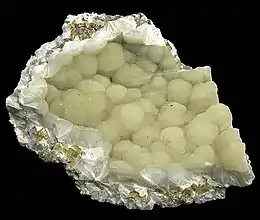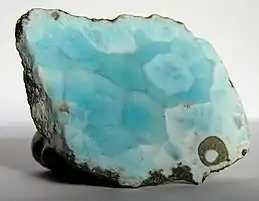Pectolite
Pectolite is a white to gray mineral, NaCa2Si3O8(OH), sodium calcium hydroxide inosilicate. It crystallizes in the triclinic system typically occurring in radiated or fibrous crystalline masses. It has a Mohs hardness of 4.5 to 5 and a specific gravity of 2.7 to 2.9. The gemstone variety, larimar, is a pale to sky blue.
| Pectolite | |
|---|---|
 | |
| General | |
| Category | Inosilicate mineral |
| Formula (repeating unit) | NaCa2Si3O8(OH) |
| Crystal system | Triclinic |
| Crystal class | Pinacoidal (1) (same H-M symbol) |
| Space group | P1 |
| Unit cell | a = 7.99 Å, b = 7.03 Å, c = 7.03 Å; α = 90.51°, β = 95.21°, γ = 102.53°; Z = 2 |
| Identification | |
| Color | Colorless, whitish, grayish, yellowish |
| Crystal habit | Tabular to acicular, radiating fibrous, spheroidal, or columnar; massive |
| Twinning | Twin axis [010] with composition plane [100], common |
| Cleavage | Perfect on {100} and {001} |
| Fracture | Uneven |
| Tenacity | Brittle; tough when compact |
| Mohs scale hardness | 4.5 - 5 |
| Luster | Silky, subvitreous |
| Streak | White |
| Diaphaneity | Translucent to opaque |
| Specific gravity | 2.84 - 2.90 |
| Optical properties | Biaxial (+) |
| Refractive index | nα = 1.594 - 1.610 nβ = 1.603 - 1.614 nγ = 1.631 - 1.642 |
| Birefringence | δ = 0.037 |
| 2V angle | Measured: 50° to 63°, Calculated: 42° to 60° |
| Dispersion | r > v weak to very strong |
| References | [1][2][3] |
Occurrence
It was first described in 1828 at Mt. Baldo, Trento Province, Italy and named from the Greek pektos – "compacted" and lithos – "stone".[2][3]
It occurs as a primary mineral in nepheline syenites, within hydrothermal cavities in basalts and diabase and in serpentinites in association with zeolites, datolite, prehnite, calcite and serpentine. It is found in a wide variety of worldwide locations.
See also
- Sérandite - the manganese analogue
References
This article is issued from Wikipedia. The text is licensed under Creative Commons - Attribution - Sharealike. Additional terms may apply for the media files.
